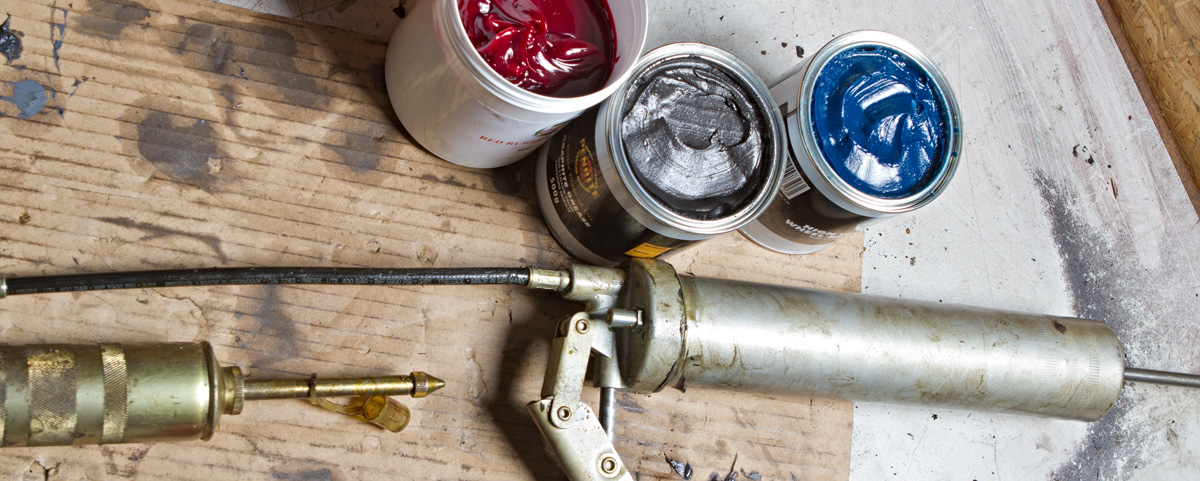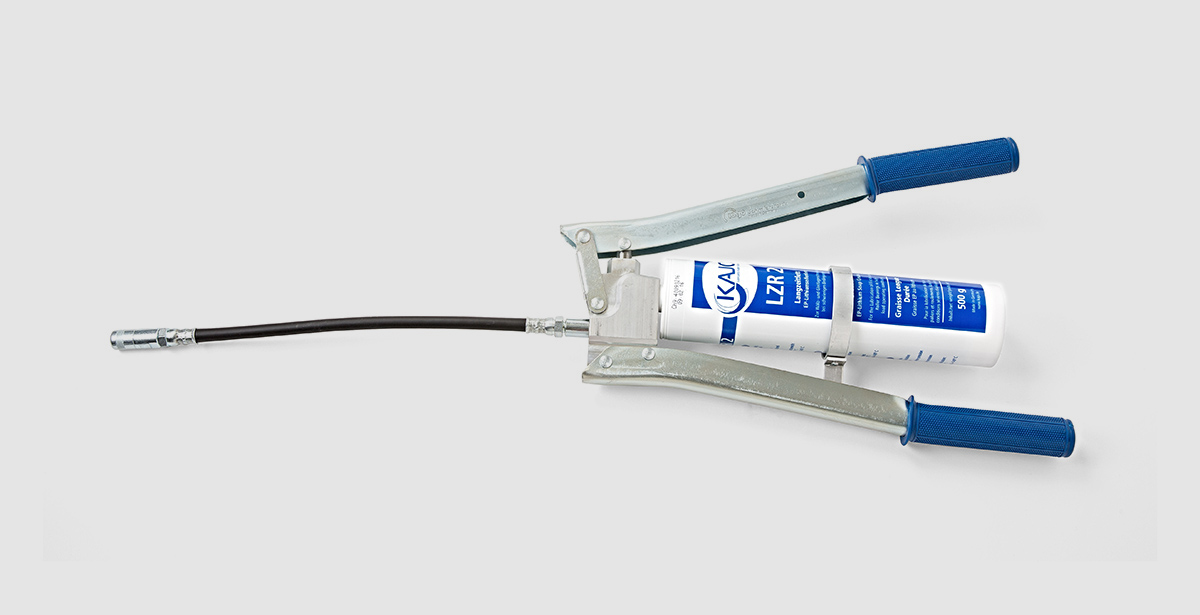What should be considered when greasing a vehicle?
A regular oil change, derusting or even a restoration are jobs that require a certain basic technical and technical understanding. The regular greasing is relatively easy when it comes to the care and maintenance of a classic car. In order to carry out this work yourself, however, a modern stage or a pit is essential, to reach the underside of the vehicle.
You can find out exactly what to look out for when lubricating a vehicle, what you need and how to proceed for correct greasing here - including instructions for operating the grease gun.< /p>

Autor: Udo Schneider
Cargo: Ventas
Actualizado: 17/01/2022

Greasing nipples, grease guns and more: the basics of greasing
In order to maintain all the functions of your collector's vehicle, regular greasing of moving parts on the chassis and drive is recommended ,
such as ...
- ... universal joints for drive shafts,
- ... steering
- ... hinge joints of the cardan shafts,
- ... the steering knuckles.
This primarily applies to classic vehicles up to the 1970s and some commercial vehicles, especially off-road vehicles and tractors.
The owner's manual for your vehicle usually comes with illustrated plans explaining which points need to be lubricated and at what intervals. If you don't have the lubrication schedule for your classic car, we at limora's customer service will be happy to help you!
We also have a selection of interesting and intelligent tools related to grease nipples. The challenge comes when the grease nipples have rotted away. But don't worry: we also have new grease nipples, metric like imperial. But first things first!
In the following, you will find out what basics you need to know about greasing, the grease gun and grease nipples.
Greasable parts vs. sealed parts: which is better?
In modern vehicles, sealed parts (packed for life) have all but replaced greaseable parts and grease nipples . Only drivers of classic or (agricultural) commercial vehicles are familiar with greasable parts.
Sealed parts have the advantage that they are significantly cheaper. In addition, they have the advantage that they do not have to be serviced explicitly and greasing is saved. However, if sealed parts run dry because the seal is defective, the grease inside is gone, the component must be replaced as a whole.
With parts that can be lubricated the advantage clearly in longevity and repairability. You can add fresh fat and press out what has penetrated. This means that dirt that has gotten in is pressed out, the bearings stay "clean" for a long time and are always well lubricated. If it is properly greased, the vehicle owner will be rewarded with a high life expectancy of the parts.
How to go about lubricating: step-by-step instructions
As already mentioned, regular lubricating should be part of the work that is carried out regularly for classic cars of all kinds. The work is neither overly complicated nor does it require a lot of accessories.
Take a close look at the lubrication plan. Lifting the car is often enough to reach the relevant places. The classic pit or a state-of-the-art stage is helpful.
Here you will find compact step-by-step instructions and thus the answer to the question: What should be considered when lubricating a vehicle?
- Read the lubrication chart and identify all grease nipples on the vehicle according to the lubrication chart.
- Remove old grease and dirt with a rag.
- If necessary, fill the grease gun with grease or a suitable cartridge.
- Put the hose on the grease gun vertically and carefully start pumping. It's often a bit difficult at first, since dirt and gummed-up fat cannot be expelled so easily.
- Once the old grease comes out, keep pumping until only clean, new grease comes out, 1-2 pumps are often enough.
- Excess grease Wipe off again with a cloth.
- Enter the maintenance book with the date and mileage.
- After a few longer rides, take another look at the grease nipples.
Tip: It's not a mistake, a few replacements -Get nipples before you start lubricating.
Instructions for the grease gun: correct filling, use and types
A grease gun basically works and looks like a classic silicone syringe. A cartridge is inserted in the interior area provided for this purpose. The inexpensive solution are 400g cartridges with mechanical grease guns, self-priming grease guns, which can be recognized by the 500g cartridge, are more elegant.
- To insert the grease cartridge , the press must be dismantled. In the first step, the press tube is unscrewed.
- Then the drawbar must be pulled back and the cover unscrewed or removed.
- The cartridge can then be inserted and the bottom of the cartridge removed.
- After screwing in the press tube, the pull rod is relieved, the clamping lever is pressed and the pull rod is pushed back.
- By pressing the vent valve, the cartridge is vented at the end.
Now for using the grease gun: by pressing on the The corresponding lever also builds up pressure inside and a small amount of grease is pressed out of the cartridge. The grease is pressed through a hose located at the end of the press and thus reaches the part of the construction to be lubricated through the nipple.
When using the appropriate attachment for grease nipples and placing the hose vertically on the nipple, no grease is sprayed next to it, but only penetrates into the desired location. Grease nipples and press attachments must therefore always match in order to guarantee professional greasing. Most grease nipples are available in standard sizes.
Tip: If your vehicle does not have standardized grease nipples, it is worth replacing them with standard models.

- Pneumatic/compressed air operated with compressor
- Push presses
- Two-handed presses: you need both hands to pump
- One-handed presses: better handling when you have to guide the hose or have to build up pressure on the nipples themselves.
- Foot pedal and standing grease guns
When asked which grease is suitable for the grease gun, we can say: It is best to use high-quality multi-purpose grease:
- Pay attention to the Temperatures that the fat has to withstand!
- Make sure the container is compatible with your press. 400g cartridges only work in 400g presses. 500gr only in 500gr. And neither can do anything with a 10 ltr. Can begin.
- Do not use layered fat. After 20 years of storage, the saponification has often hardened and the fat can hardly be processed.
What can go wrong when lubricating?
Lubricating is a rather dirty job. Technically, hardly anything can happen. Sometimes it can happen that sealing rings are slipped on. Grease guns operated with compressed air in particular require attention at work.
Conclusion: why lubrication is so important
If you want to drive your classic car as reliably as possible, then a Regular greasing essential. Above all, younger owners of a classic vehicle are no longer aware of this process, because today's everyday vehicles almost exclusively have maintenance-free chassis constructions.
This also results in the problem that greasing is not part of everyday life, even in larger workshops. It is all the more important to regularly lend a hand. Because if the grease at the lubrication points becomes old and tough, this has the following effects:
- The lubricating properties are no longer fulfilled.
- Moisture penetrates into parts where it is better kept away.
- Needle bearings "overgrown" with shafts. This reduces the chassis suspension, which puts a lot of strain on surrounding components including the frame.
- Bearings and bushings made of bronze or other bearing metals wear out, become oval or there is play.
- One of the most common defects in the classic car inspection are worn chassis components, especially steering knuckles. Such errors can be reliably avoided by regular lubrication, monthly or every 1000 km.
- If little lubrication is used, the usability of the grease nipples becomes increasingly poor and grease no longer penetrates all areas of the component. Only regular lubrication maintains the supply of lubricant in the component.